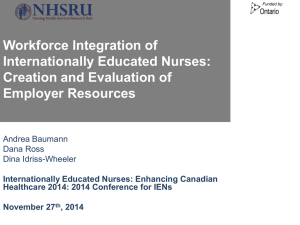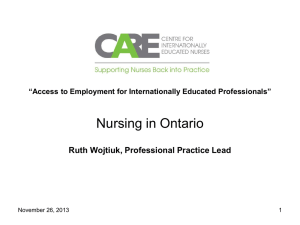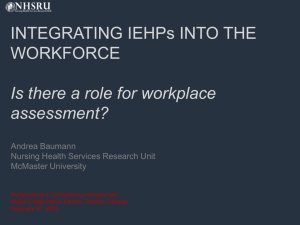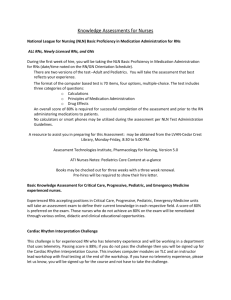Employment Experiences of Internationally Educated Registered Nurses (IENs)
advertisement
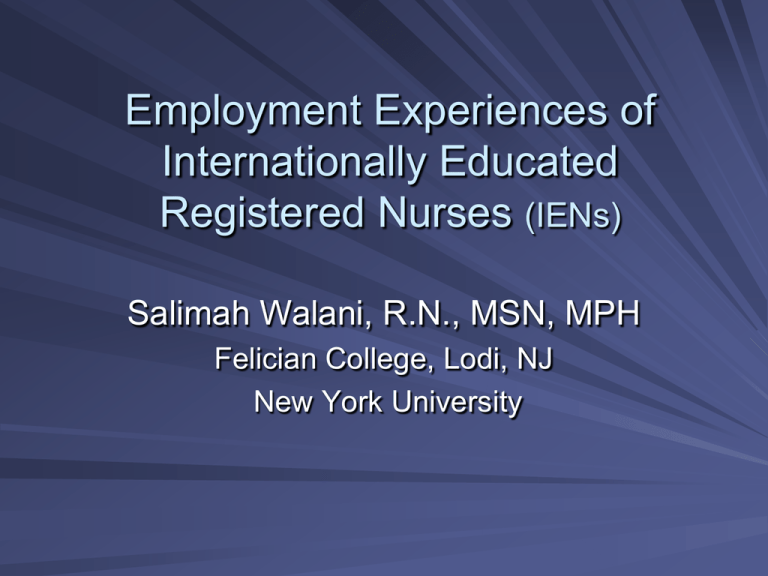
Employment Experiences of Internationally Educated Registered Nurses (IENs) Salimah Walani, R.N., MSN, MPH Felician College, Lodi, NJ New York University “Regardless of the opinions about the desirability of using foreign-educated RNs to supply the U.S. nurse labor market, we anticipate the labor market for RNs will become a global market. Thus in a global market, free of entry barriers, RNs would be able to move freely to countries that offer the most attractive wages, benefits, and working conditions.” Buerhaus, Staiger & Auerbach (2009, p.297). The Future of the Nursing Workforce in the United States: Data, Trends and Implications Purpose To describe the employment experiences of IENs in destination countries – United States (US) – United Kingdom (UK) – Canada Qualitative and quantitative studies – Nursing practice values – Income and job position – Employment discrimination Global Migration of IENs Estimated shortage of health professionals= 4 million worldwide UK, US, Australia, New Zealand, Ireland: ↑ health professional migration US: RNs- projected shortfall of 500,000 by 2020 – 3.5% - 9% of RNs in the US are IENs – 1990-2000: 40% increase in IEN proportion in the US Significance Civil Rights Act of 1964 – 2007: 9000 charges of national origin discrimination (EEOC) 60% of IENs: non-white- race interaction Ethics of migration Recent legal cases involving IENs – Missouri 1999 : 2.1 million settlement – New York 2006 -2009 Literature Search Proquest, CINAHL, Medline (10 yrs) Grey literature - Google and Yahoo Hand search of references Keywords: wages, job inequalities, foreign workers, immigrants, immigrant nurses, foreign nurses, international nurses, international healthcare professionals, nurse migration, discrimination, employment discrimination, human capital and returns to education Definitions of IEN RNs born in another country but received basic nursing education in the US RNs born in the US but received basic nursing education in another country RNs born in another country and received basic nursing education in another country Terms used in the literature: – Foreign, foreign-educated, foreign-born, foreign-trained, immigrant, overseas and IEN. Nursing Practice Values Flynn & Aiken (2002) – Survey of 252 RNs from collectivistic culture with 547 IENs from individualistic culture – 20 hospitals in 11 US cities O’Brien-Pallas & Wang (2006) – 6000 Canadian-born, 415 foreign-born Both used Nursing Work Index – no significant differences in the nursing practice values of the two groups. Income and Job Positions United Kingdom Royal College of Nursing Survey (2007) – 64% of minority IENs in grade D compared to 26% of minority UK-qualified RNs. – Rate of success in promotion 40-48% for IENs compared to 53-54% for UK-qualified. Buchan et al. (2006) – 87% of IENs in London were in grades D & E – IENs from Asia and Africa: more likely to be in lower grades compared to IENs from Australia and New Zealand. Income and Job Positions Canada 2001 Canadian Census data analyses (Buhr, 2006) – 29000 Canadian-educated & 1000 IENs – Controlled human capital variables – IENs earned 9% (p< 0.001) lower wages than Canadian RNs Income and Job Positions United States Two studies (Polsky et al., 2007 & Xu & Kwak, 2005) US Census data and NSSRN data Compared mean annual income of IENs and USNs Results: IENs earn $6000- $10,000 more per year No controls for work setting, education and experience Experiences of Employment Discrimination, UK 1 quantitative survey (RCN, 2007) – IENs reported ↑ bullying and harassment – ↓ satisfied with employer handled the above 5 qualitative studies – Reported discrimination, stigmatization – Felt unwelcomed, unappreciated, devalued – Unfair work distribution, ↓ equal opportunity Reported national origin and race as basis for discrimination experience Experiences of Employment Discrimination, Canada Survey of 6,477 RNs (O’Brien-Pallas & Wang, 2006) found that IENs reported: – ↑ physical, verbal & emotional abuse – ↓ unpaid time, tuition benefit, flexible schedule Qualitative study (Hagey et al., 2001) – Interviews of 9 IENs who filed separate employment discrimination grievances – marginalized, harassed and unsupported Experiences of Employment Discrimination, US Two qualitative studies (Dicicco-Bloom, 2004; Yi & Jesewski, 2000) 10 IENs from India – Discrimination in job assignments, promotion & Job assignments 12 IENs from Korea – No mention of discrimination Conclusions Nursing Practice Values – IENs do not differ from USNs Income and Job Position – UK- Strong evidence that IENs are in lower job positions – Canada- Moderate evidence of income inequality – US- limited and inconclusive Employment Discrimination – UK - Strong evidence of IEN employment discrimination – Canada and US: Limited evidence Research Gaps Scarce research on employment experiences of IENs in the US No US studies were found about: – Comparison of IEN and USN in terms of wages and job positions in a well specified model – Comparison of hourly wages instead of annual income – Extent to which race impacts employment outcomes of IENs THANK YOU
